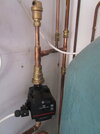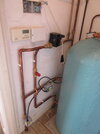The rise in level is due to expansion in the whole system, mainly the rads, not just the F/E tank (if it warms, which ideally it shouldn't!).
So there are instances where an OV system's F&E cistern's water will warm up and that would be considered normal operation.
The trouble starts when the feed and vent sections start to clog up though, depending on where the actual restriction is and then the pump can start to send more water up either the feed or the vent.



